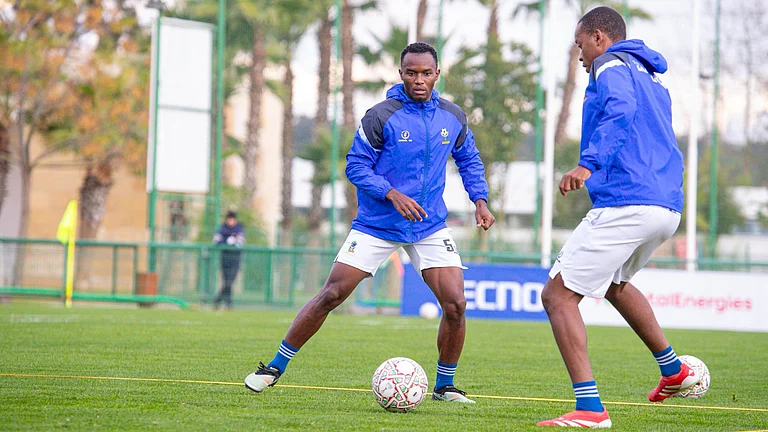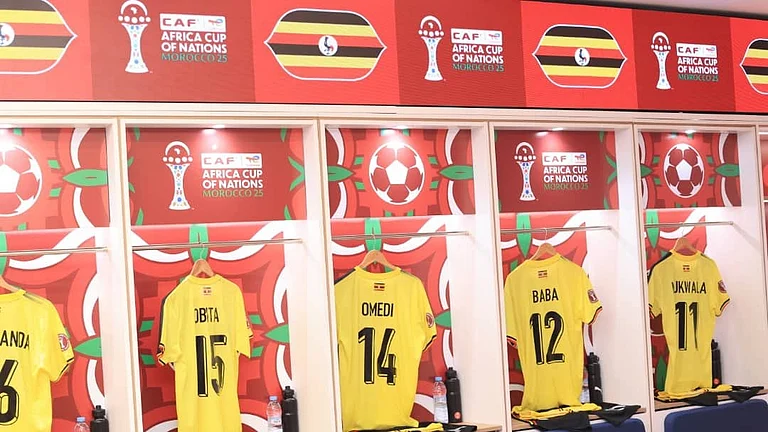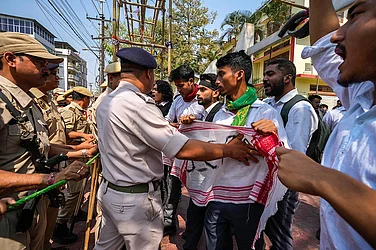Over the past week, hundreds of students across Kashmir, including a large number of women, have been taking to the streets demanding justice for the eight-year-old Bakarwal girl who was raped and murdered in Jammu’s Kathua district this January. Worried that the massive demonstrations might lead to another pro-azadi upsurge on the lines of 2016 and 2017, government forces resorted to heavy teargas shelling and pellet firing to disperse the demonstrators, leading to stone-pelting by students trying to hold their ground. Several protesters were injured by pellets in their eyes.
At a loss to understand why the students are protesting, J&K government spokesperson and PDP leader Naeem Akhtar asked, “What is the occasion for protests and stone-pelting when the (Kathua) case is solved, with the accused in custody and facing trial? Shouldn’t they be attending classes instead?” Education minister Altaf Bukhari, in fact, threatened to close down educational institutions in the Valley if the students didn’t stop protesting.
While Kashmir was being rocked by protests for justice to the raped and murdered girl, Jammu was witness to a procession of another sort on April 19, led by sacked J&K environment and forest minister Chaudhary Lal Singh of the BJP, seeking the transfer of the case from the J&K Police to the CBI. In sharp contrast to the protests in the Valley, there was no attempt to stop the march in Jammu, or the one in Kathua the next day by the J&K National Panthers Party raising the same demand. Lal Singh had resigned along with then industries minister Chander Prakash Ganga after widespread outrage over their participation in the March 1 rally of the Hindu Ekta Manch in support of the accused arrested in the case.
Despite the protests in Kashmir and Jammu taking contrary stands on the same issue and revealing the highly polarised nature of the state’s polity, both the ruling coalition partners—the PDP and the BJP—claim the alliance would continue to bring the two regions closer. Clearly, it won’t be easy. For starters, the two parties differ over how the Kathua atrocity should be investigated, with the BJP showing lack of trust in the police force under the government it is part of. And yet the coalition, going by how it has weathered the storms emanating from differences over almost everything so far, hopes to tide over the latest faceoff as well and continue at the helm until the end of the government’s term in 2020.

Former J&K minister Lal Singh at a Jammu rally
Political observers say the urge to hold on to power is the glue binding the two parties that many say are as different as chalk and cheese. In Kashmir, the PDP is widely accused of turning into a “consortium of business interests” ready to make daily compromises to continue in the alliance, while in Jammu, the BJP is seen as “a crowd of delusional novices who have demonstrated complete indifference to the duty of governance and are more often seen fighting protocol wars among themselves”. Parties based in the Jammu-Kathua-Udhampur sector, such as the Panthers Party, have been accusing the BJP of giving up on Jammu’s interests and “hurting Dogra pride” by allowing the J&K Police’s Crime Branch to probe the Kathua case. In Kashmir, on the other hand, the PDP is seen as catering to all the demands of the BJP and the Centre, such as using force against student demonstrators in the Valley.
Analysts say the “anti-BJP mobilisation” led by Lal Singh and the Panthers in Jammu would compel the BJP to show foresight and not walk out of the ruling coalition, which would harm both partners. Provincial president of the National Conference, Davinder Singh Rana, tells Outlook that both the BJP and the PDP cannot afford assembly polls at this time as they have failed to live up to the aspirations of those who voted for them. “Both have betrayed the mandate they got in 2014,” says Rana. “Kashmir is boiling, Jammu is on the edge and Ladakh is also simmering. There is developmental inertia, discontent and alienation among the youth in Jammu as well as Kashmir.” Rana believes the poor performance of both the parties would keep them together.
Meanwhile, the BJP has asked all its ministers except deputy CM Nirmal Singh to resign and make way for a reshuffle after April 25. While the party’s state spokesman Arun Gupta claims the government has followed the coalition’s Agenda of Alliance (AoA) over the past three years, done “unprecedented work on the development front” and would continue to stick to the AoA framework for the remaining three years of the term, he chooses silence on whether the Centre would act upon the political agenda of the AoA, which includes opening roads across the Line of Control (LoC) and entering into a dialogue with the separatists and the Pakistan government. CM Mufti tells Outlook that the appointment of former Intelligence Bureau chief Dineshwar Sharma as the Kashmir interlocutor was the beginning of the political process, though the party wants more.
The AoA had emerged from close collaboration between the BJP general secretary in charge of J&K, Ram Madhav, and the PDP’s Haseeb Drabu, who was incidentally removed from the post of finance minister in March. In the AoA, both the parties agreed to follow former PM Atal Behari Vajpayee’s “Insaaniyat, Kashmiriyat aur Jamhooriyat” approach, and PDP leaders claim the coalition government has been doing just that. Akhtar says he cannot predict the future, but there is no alternative to the PDP-BJP alliance if the interests of the state and the country are to be served. “If this government breaks down, it can create more problems,” he says. “It’s this alliance that is holding the state together despite the partners having different mandates, which are pulling the state in different directions. It needed a statesman like the late Mufti Mohammad Sayeed to convert that challenge into an opportunity. The AoA is a roadmap for reconciliation and solution of many major problems.”
Akhtar points out that the PDP has been waiting for more decisive and proactive intervention by PM Narendra Modi in Kashmir. “If this (alliance) experiment fails, it will be a very long time before we have another credible democratic alternative. So it is the responsibility of both partners to continue in good faith. The Centre, too, needs to contribute more, not just economically, but at a political level,” says the spokesperson.
Relieved that the BJP removed the two ministers on its insistence, the PDP hopes it would strengthen the coalition. “Kathua was not a regional issue, but one of justice for the victim, and both the parties were on the same page as the state government on this from day one,” says Waheed-ur-Rehman Parra, who is seen to be close to the CM. “The alliance stands for the larger cause of bringing Kashmir and Jammu together, and to bring the people of Kashmir and the rest of the country together. It would take time.”
The Opposition in J&K also believes the ruling coalition will survive another three years. “We are more worried if the state will survive,” says the National Conference state spokesman Junaid Azim Mattu. “In Kashmir, the situation is going from bad to worse, even as the vast region of Jammu seems to be on the edge with widespread communal tension instigated by people at the helm of affairs. The very nature of the PDP-BJP alliance is such that it finds relevance only by pitting the two regions against each other.”
By Naseer Ganai in Srinagar


























